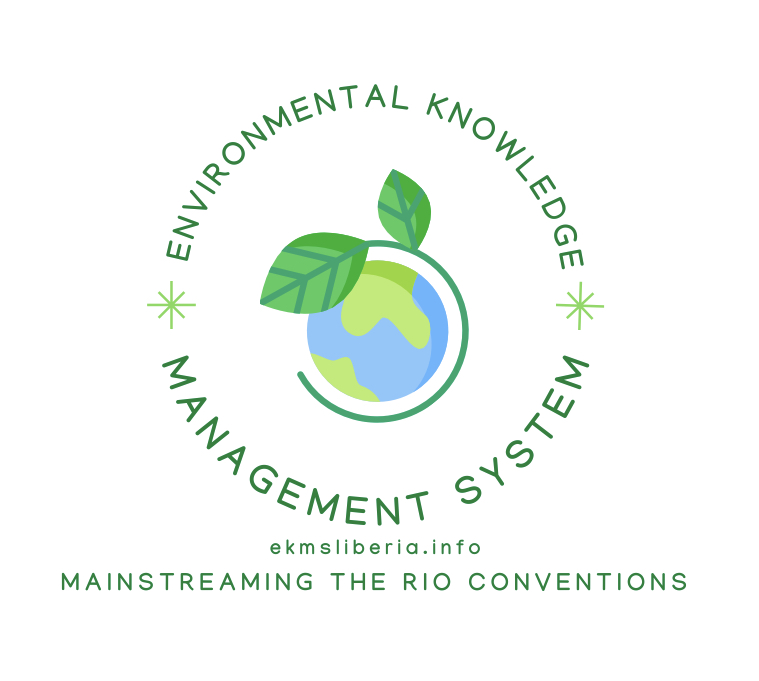GENERAL
The Environmental Knowledge Management System is a knowledge platform that strengthens institutional coordination between the Environmental Protection Agency (EPA), other Government institutions that have direct linkages with environmental policies and development. This platform will increase access and dissemination of key information and promote inadequate public awareness and education.
It focuses on how the Rio conventions are being implemented in Liberia.
Government Institutions, International and National NGOs that have direct linkages with environmental policies and development, are invited to join the EKMS team. Interested individuals could also submit useful data to the EKMS. Please see our institutions resources to know which institutions are currently participating.
Join our community forum for free, if you are interested in discussing issues indepth. You can also share discussed topics with your own group on Facebook, Twitter, or Linkedin. Thank you for your interest in the EKMS.
Use the smart search feature on the homepage to search for keywords or better still select a category.
UNFCCC
Accreditation usually opens two months prior to the meeting. It is advisable to apply for accreditation in advance, to avoid any unnecessary delays at the meeting venue.
All official texts, data and documents are in the public domain and may be freely downloaded, copied and printed provided no change to the content is introduced, and the source is acknowledged. You can find graphs and data in our background publications and the GHG data section of our website.
No, each participant must be properly accredited and registered.
There are different participation groups at UNFCCC meetings; these include:
Government delegate, duly nominated as part of the official delegation from one of the Parties to the Convention and/or its Kyoto Protocol, or as a delegate from an observer State. Nominations for delegations are received from the respective governments, usually through the National Focal Point. For sessions of the COP and CMP, official credentials are issued by the Head of State or Government or by the Minister of Foreign Affairs.
Observers from admitted non-governmental or intergovernmental organizations. Nominations must be made by the Designated Contact Points of admitted organizations using the online registration system (ORS). Please see the civil society web page for more information.
Observer from a United Nations organization or specialized agency. Nominations are received from the respective organization.
Member of the press. Media participation at UNFCCC Conferences is subject to accreditation by the UNFCCC secretariat. Accreditation is strictly reserved for members of the press who fully meet UN media accreditation requirements. For more information, please visit the accreditation section.
The UN Framework Convention on Climate Change (UNFCCC) is an intergovernmental treaty developed to address the problem of climate change.
Climate neutrality is achieved by balancing the amount of emissions generated with the Earth’s natural capacity of to absorb them. Climate neutrality is not necessarily about zero emissions. Instead, it is about reducing our current global emissions to the point where we reach a balance between our emissions and the absorptive capacity of the Earth.
UNCBD
The Convention on Biological Diversity (CBD) is an international legally-binding treaty with three main goals: conservation of biodiversity; sustainable use of biodiversity; fair and equitable sharing of the benefits arising from the use of genetic resources.
Conservation of biological diversity leads to conservation of essential ecological diversity to preserve the continuity of food chains. The genetic diversity of plants and animals is preserved. Biodiversity conservation serves as an insurance policy for the future.
Biodiversity meet ensures awareness and some rules which leads to preservation of endangered and extincting species . This will unite all nations to conserve their biodiversity.
Support the birds, reptiles, mammals, and plants that live in your neighborhood. You can also attract more wild species by providing water, food, shelter, and privacy. Explore habitats in your area. Help clean up and protect beaches, parks, reserves, and fields where wild plants and animals live.
The loss of biodiversity affects the lives of more than 1 billion people living in dry lands.
5 major threats to biodiversity;
Climate change
Deforestation and habitat loss
Over-exploitation
Invasive species
Pollution
UNCCD
The United Nations Convention to Combat Desertification in Those Countries Experiencing Serious Drought and/or Desertification, Particularly in Africa (UNCCD) is a Convention to combat desertification and mitigate the effects of drought through national action programs that incorporate long-term strategies supported by international cooperation and partnership arrangements.
Established in 1994, the United Nations Convention to Combat Desertification (UNCCD) is the sole legally binding international agreement linking environment and development to sustainable land management
Desertification is not the natural expansion of existing deserts but the degradation of land in arid, semi-arid, and dry sub-humid areas. It is a gradual process of soil productivity loss and the thinning out of the vegetative cover because of human activities and climatic variations such as prolonged droughts and floods.
Desertification is at the root of political and socio-economic problems and poses a threat to the environmental equilibrium in affected regions. The land’s loss of productivity exacerbates poverty in the drylands, forcing its farmers to seek a way of living in more fertile lands or cities. In fact, 135 million people- the equivalent to the population of Germany and France combined – are at risk of being displaced as a consequence of desertification.
Desertification is a worldwide problem directly affecting 250 million people and a third of the earth’s land surface or over 4 billion hectares. In addition, the livelihoods of some one billion people who depend on land for most of their needs and usually the world’s poorest in over one hundred countries are threatened.

